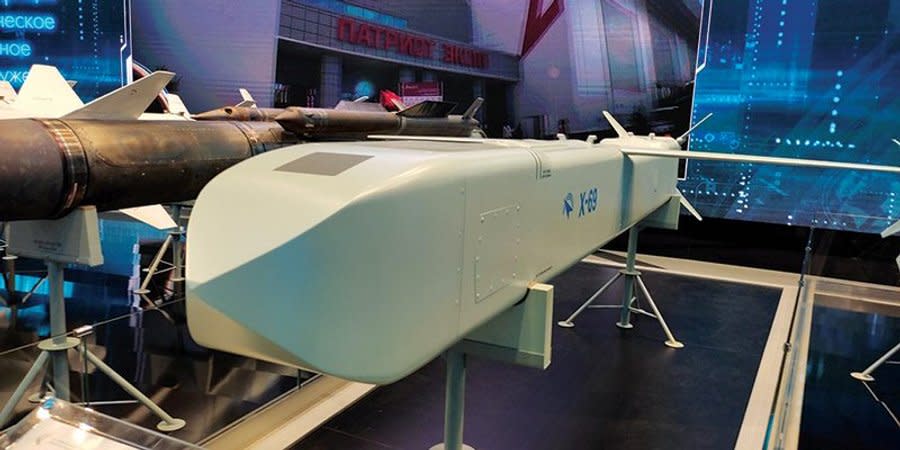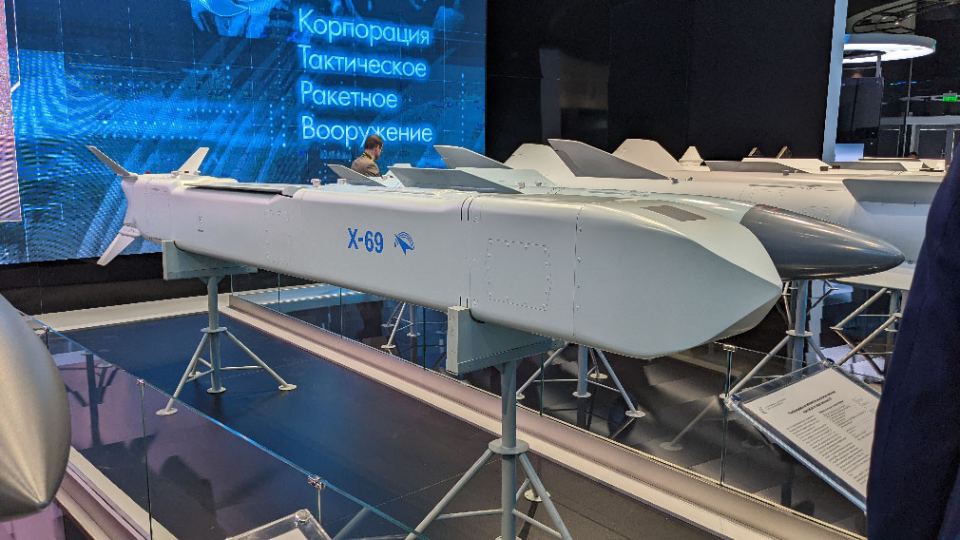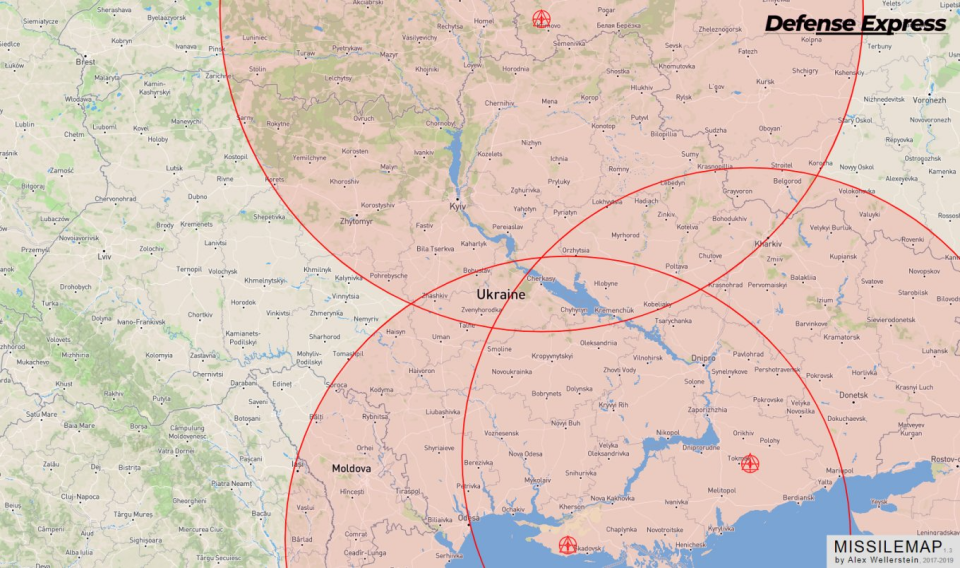How do Russia's Kh-69 missiles measure up against the West's best?

The recent attack on Trypillia Thermal Power Plant, resulting in its complete destruction, is believed to have been executed using Russia's latest cruise missile, the Kh-69, which shares similarities with Western missiles like the Storm Shadow/SCALP and Taurus.
"This weapon, originally developed for Su-57 (newest Russian jet fighter), is far more advanced than most Russian air-launched tactical munitions," The War Zone reported in February 2024.
NV delves into the specifications and potential threats posed by the Kh-69 missiles.
The Kh-69: Russia's answer to Western missiles
Developed by Raduga, a Moscow-based design bureau specializing in cruise missiles and now facing Western sanctions, the Kh-69 emerged as one of Russia's recent innovations. It was publicly unveiled at the Army-2022 military forum and later showcased at the Dubai Airshow 2023. Russia lauds the Kh-69 as a multi-functional, stealthy, and precise next-gen air defense missile.

However, external experts note that the Kh-69 likely evolved from the earlier Kh-59MK2 missile. Significant redesigns post-2015 have given the Kh-69 distinctive features such as a square cross-section body, retractable wings, four tail fins, and an internal turbojet engine, aligning it more closely with the German Taurus missiles.
Despite these advancements, its guidance system, relying on inertial navigation with GLONASS corrections and an optoelectronic homing mechanism, remains largely unchanged from its predecessor, drawing parallels with Russia's strategic Kh-101/X-555 missiles.
As of September 2023, the Kh-69 was undergoing flight tests, and experts from the International Institute for Strategic Studies (IISS) noted its resemblance to the Storm Shadow and Taurus missiles, albeit with a smaller size and payload.
The War Zone experts confirm that even before their use in Ukraine, Russian Kh-69s were indeed compared to Storm Shadow and its French equivalent SCALP in terms of their hypothetical capabilities. However, these western missiles have a longer range and are also larger in size: in terms of length and payload, the Kh-69 is about two-thirds the size of the Storm Shadow/SCALP.
Capabilities and deployment
Unconfirmed characteristics of the Kh-69 missile include:
guidance accuracy - maximum deviation of up to 16 feet
flight range - previously stated to be up to 180 miles (however, specialists of Ukrainian website Defence Express received additional information, according to which range of missile launched at Kyiv Oblast on April 11 was actually 250 miles)
missile weight - 1500 lbs
speed - from 195 to 277 mph (i.e., missile is subsonic)
fuselage length - 13.74 feet
width and height with folded wings and plumage - 15.78 inches
wingspan - 6.56 feet
payload - 660-680 lbs
Inventory and impact
The Kh-69 missile, designed specifically for Russia's cutting-edge Su-57 fighter jets, represents a significant advancement in Moscow's military arsenal. While the Su-57s have seen limited action in Ukraine due to their high costs and scarce numbers, the adaptability of the Kh-69 missiles to be fitted onto more commonly used fourth-generation Russian aircraft like the Su-35 and Su-34 poses a growing concern for Ukrainian defenses.
According to missile developers, the Kh-69's unique square body design allows it to be equipped not only on the advanced Su-57s but also on a range of fourth-generation fighter jets widely deployed in the ongoing conflict. This versatility means that Russian forces could potentially increase the use of these sophisticated missiles, leveraging the broader fleet of Su-34 and Su-35 bombers already active near the frontline.
Defense experts from Defence Express highlight the strategic implications of this capability, noting that the potential for a wider deployment of Kh-69 missiles could significantly amplify the threat to Ukraine. Especially concerning is the missile's reported range of 250 miles, which, if accurate, would enable Russian forces to strike deep into Ukrainian territory, including key locations like Kyiv, from relatively safe distances.
Despite the looming threat, the extent of Russia's Kh-69 arsenal remains a question. Industry analysts suggest that Russia hasn't reached full-scale production of these missiles, indicating that large stockpiles are unlikely at this point. A missile analyzed in February 2024 bore manufacturing marks from the end of 2023, hinting at the nascent stage of the Kh-69's production lifecycle.
Read also:
Russia imported nearly $2 billion worth of war chips last year, most made in U.S. and EU
Russian missile strike in Kharkiv Oblast cuts power for 200,000
At the same time, if the missile's range of 250 miles is confirmed, this is a sufficient radius to hit a significant number of targets on the territory of Ukraine (including Kyiv) from tactical aircraft, i.e. the same Su-34 or Su-35, which can approach borders or front lines, analysts explain.
Below is the estimated radius of the Kh-69 strike range on a graphic from Defense Express.

How many such missiles does Russia have?
While analysts indicate that Russia has not yet ramped up to full-scale mass production of the Kh-69 missiles, with limited stockpiles available, the capabilities and potential targets of these missiles are drawing significant attention. According to Defence Express, a missile analyzed in February 2024 was manufactured at the end of 2023, suggesting recent production.
What targets can Kh-69 hit?
The Kh-69 is engineered to strike stationary targets with precise coordinates, capable of being pre-programmed or loaded mid-flight. The War Zone outlines that these missiles are particularly aimed at hitting critical infrastructures and military assets with known locations. This strategic approach was underscored when the Trypillia thermal power plant in Kyiv Oblast became a target, showcasing the missile's potential in hitting vital Ukrainian facilities.
Read also: Russia strikes power plant near Kyiv with new Kh-69 missiles — report
Russian sources have touted the Kh-69's ability to target a range of stationary objectives, including communication nodes, transport hubs, ammunition depots, command centers, industrial facilities, power plants, and even docked ships, painting a broad canvas of potential targets within its strike capability.
Can Ukraine down this missiles?
However, Ukraine's resilience against such advanced weaponry is noteworthy. The first known use of Kh-69 missiles against Ukraine on February 7 led to significant analysis, with Ukrainian forces reportedly downing five out of six guided missiles (Kh-59 and Kh-69) launched over Poltava, Sumy, and Mykolaiv regions. These successful interceptions were later verified by experts from the Kyiv Scientific Research Institute of Forensic Expertise, marking a crucial milestone in understanding and countering this new threat.
Read also: Russia hits Lviv Oblast with hypersonic Kinzhal missiles – less than 150 km from NATO territory
As for possibility of shooting down Kh-69 and their analogues aka Kh-59MK2 missiles, Defence Express experts have previously reminded that this is a difficult air target for Ukrainian air defense, as it is quite small in size. In particular, such missiles are even smaller than wings of the Kh-101 missile (13.77 feet for the Kh-59MK2 / Kh-69 and 23 feet for Kh-101, respectively).
"This circumstance significantly complicates downing of Kh-59 cruise missiles, so each defeat of such an air target is an outstanding result of Ukrainian air defense forces," analysts said.
And after Kh-69 strike on the Trypillia Thermal Power Plant on April 11, they added that this result "unfortunately indicates possibility of its penetration of depleted Ukrainian air defense."
After April 11 attack, Ukrainian Air Force spokesman Ilya Yevlash called Kh-69 missile an "improved version of the Kh-59". According to him, it is currently being established what kind of missile it was and its type.
Yevlash suggested that Western air defense systems are capable of shooting down such missiles.
"Russia used similar missiles before," Yevlash said.
"These are fresh missiles with parts manufactured in 2023. So we can see that Russia is constantly trying to produce new missiles. However, it all depends on success of their production, how quickly they can provide themselves with various semiconductors, chips, etc."
"Of course, the Kh-69 missile is a new missile for us, so we are also studying how we can counter it. Most likely, Patriot air defense system will also be able to counter it, as it has fought against quite more sophisticated types of missiles, such as hypersonic ones, Zircon and Kinzhal," Yevlash added.
Read also: Over 50% of Russian-made microchips defective
We’re bringing the voice of Ukraine to the world. Support us with a one-time donation, or become a Patron!
Read the original article on The New Voice of Ukraine

